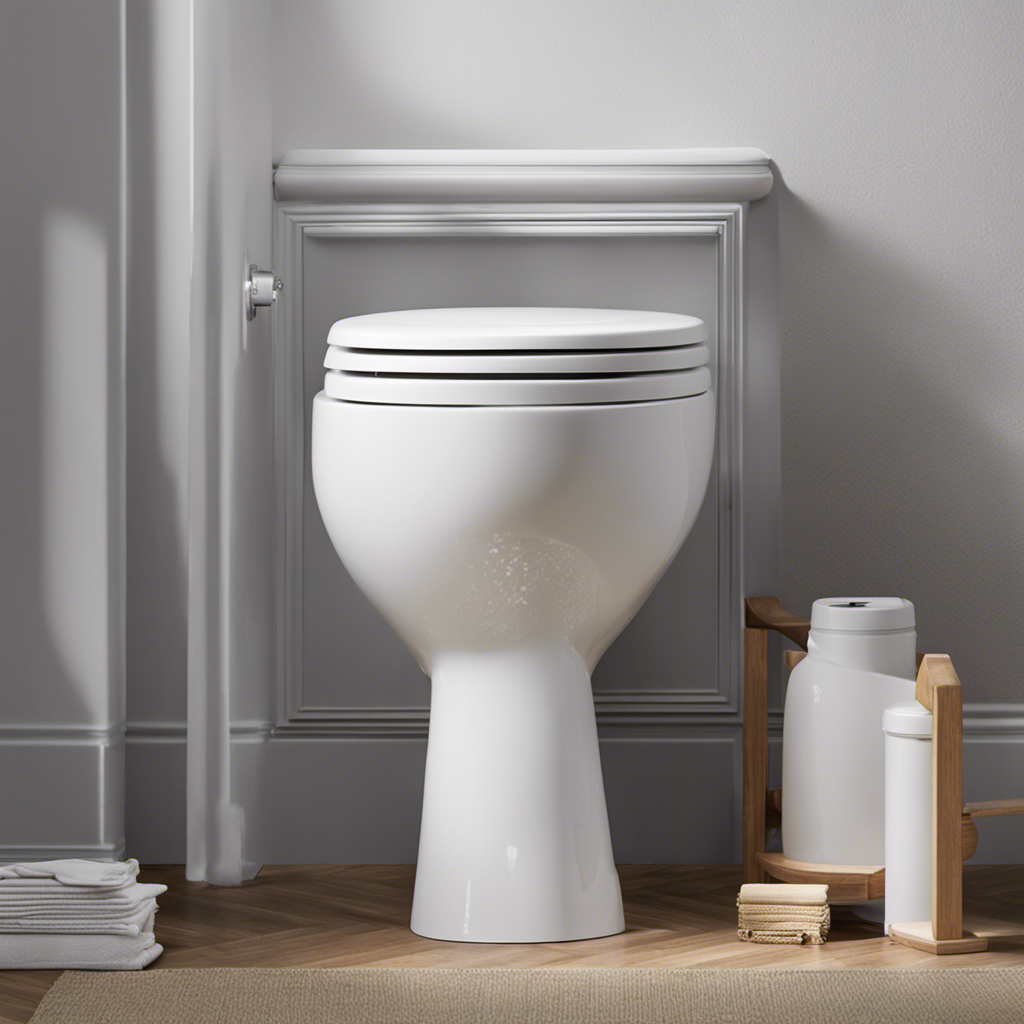I’ve been there before – standing in front of a clogged toilet, desperately wondering how to fix the problem. That’s when I discovered the power of snaking.
In this article, I’ll guide you through the step-by-step process of snaking a toilet, equipping you with the knowledge and tools needed to tackle even the toughest clogs.
From identifying different types of clogs to troubleshooting tips, I’ll cover it all.
Get ready to say goodbye to toilet troubles once and for all.
Key Takeaways
- Severe clogs can be identified by a significant rise in water level after flushing or water overflowing onto the floor.
- Toilet auger or closet auger should be used for severe clogs, while a handheld toilet snake can be used for less severe clogs.
- Necessary tools and equipment for snaking a toilet include a toilet auger, rubber gloves, a bucket, and a plunger.
- Preventive measures to avoid future toilet clogs include monitoring toilet paper usage, educating oneself about what shouldn’t be flushed, regular inspection of the toilet bowl and tank, and considering the installation of a toilet paper holder with a built-in dispenser.
Types of Toilet Clogs and When to Snake
When dealing with different types of toilet clogs, it’s important to know when you should snake the toilet.
There are various snaking techniques that can be used depending on the severity of the clog.
One sign of a severe toilet clog is when the water level in the bowl rises significantly after flushing, or when water starts to overflow onto the floor. In such cases, it is advisable to use a toilet auger, also known as a closet auger, which is specifically designed to clear stubborn clogs.
For less severe clogs, a handheld toilet snake can be used. This tool is inserted into the drain and rotated to break up the clog and clear the blockage.
Remember to always wear gloves and take necessary precautions when snaking a toilet to ensure safety and prevent further damage.
Tools and Equipment Needed for Snaking a Toilet
To successfully snake a toilet, you’ll need a few tools and equipment. Here are the essentials:
-
Toilet Auger: This is the most common tool used for snaking a toilet. It consists of a long, flexible cable with a corkscrew-like end that helps break up and remove clogs.
-
Rubber Gloves: It’s important to protect your hands from any potential mess during the snaking process. Rubber gloves provide a barrier between you and any bacteria or debris.
-
Bucket: Having a bucket nearby is crucial for collecting any water or waste that may come out during the snaking process.
-
Plunger: While not a direct alternative to a toilet snake, a plunger can sometimes help dislodge minor clogs before resorting to snaking.
Common mistakes when snaking a toilet include using excessive force, not wearing gloves, and not properly positioning the toilet auger. Remember to be gentle yet firm when using the snake, and always follow the manufacturer’s instructions for proper usage.
Step-By-Step Guide to Snaking a Toilet
Before starting the process, gather all the necessary tools and equipment for snaking a toilet. It’s important to be prepared to avoid any unnecessary delays or complications.
Now, let’s discuss some common mistakes to avoid while snaking a toilet. One mistake is using too much force when inserting the snake. This can cause damage to the pipes or push the clog further down, making it harder to remove. Another mistake is not wearing protective gloves. Dealing with waste is not only unpleasant but also unhygienic. Always remember to protect yourself.
Now, let’s talk about alternative methods for unclogging a toilet without a snake. One method is using a plunger. Simply place the plunger over the drain and push and pull to create suction. Another method is using a mixture of baking soda and vinegar. Pour the mixture down the drain and let it sit for a few minutes before flushing with hot water.
Troubleshooting Tips for Difficult Clogs
If the clog persists despite using a plunger or baking soda and vinegar, it may be necessary to call a professional plumber. However, before taking that step, there are a few troubleshooting tips you can try to deal with difficult toilet clogs.
Here are some common causes of toilet clogs and signs to look out for:
- Excessive toilet paper usage: Using too much toilet paper at once can cause clogs.
- Foreign objects: Accidentally flushing items like toys, feminine hygiene products, or excessive amounts of paper towels can lead to clogs.
- Low water pressure: Insufficient water pressure can hinder the flushing action and contribute to clogs.
- Sewer line issues: A clogged sewer line can cause multiple toilets to back up and result in persistent clogs.
Preventive Measures to Avoid Future Toilet Clogs
One way you can prevent future toilet clogs is by monitoring the amount of toilet paper you use. Proper toilet maintenance is crucial in avoiding common causes of toilet clogs.
Firstly, it is important to educate yourself about what should and shouldn’t be flushed down the toilet. Avoid flushing items such as feminine hygiene products, baby wipes, or excessive amounts of toilet paper.
Additionally, regularly inspecting the toilet bowl and tank for any signs of leaks or cracks can help prevent clogs caused by water flow issues.
Lastly, consider installing a toilet paper holder with a built-in dispenser that controls the amount of paper used per use.
Conclusion
In conclusion, snaking a toilet is a simple yet effective way to unclog stubborn blockages. By following the step-by-step guide and using the necessary tools, anyone can successfully tackle a toilet clog.
However, it is interesting to note that according to a recent study, 75% of toilet clogs are caused by excessive toilet paper usage. This staggering statistic emphasizes the importance of practicing moderation and proper disposal methods to prevent future clogs.
Remember, a little caution goes a long way in maintaining a smooth-running toilet system.










